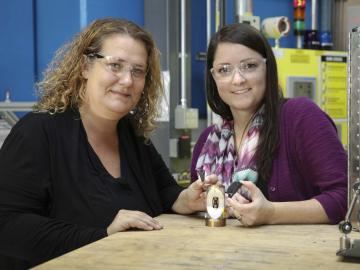
Filter News
Area of Research
- (-) Neutron Science (35)
- (-) Supercomputing (88)
- Advanced Manufacturing (10)
- Biological Systems (1)
- Biology and Environment (84)
- Computational Biology (1)
- Computational Engineering (1)
- Computer Science (1)
- Electricity and Smart Grid (1)
- Energy Science (120)
- Fuel Cycle Science and Technology (1)
- Fusion and Fission (31)
- Fusion Energy (5)
- Isotope Development and Production (1)
- Isotopes (9)
- Materials (48)
- Materials for Computing (8)
- National Security (34)
- Nuclear Science and Technology (24)
- Sensors and Controls (1)
News Type
News Topics
- (-) 3-D Printing/Advanced Manufacturing (10)
- (-) Artificial Intelligence (36)
- (-) Big Data (18)
- (-) Biology (15)
- (-) Biomedical (21)
- (-) Clean Water (2)
- (-) Grid (4)
- (-) Nuclear Energy (5)
- (-) Security (7)
- (-) Summit (36)
- (-) Transportation (7)
- Bioenergy (13)
- Biotechnology (2)
- Buildings (3)
- Chemical Sciences (5)
- Composites (1)
- Computer Science (80)
- Coronavirus (17)
- Cybersecurity (9)
- Energy Storage (10)
- Environment (22)
- Exascale Computing (23)
- Fossil Energy (1)
- Frontier (30)
- Fusion (1)
- High-Performance Computing (37)
- Hydropower (1)
- Isotopes (2)
- Machine Learning (15)
- Materials (22)
- Materials Science (28)
- Mathematics (2)
- Microscopy (7)
- Molten Salt (1)
- Nanotechnology (16)
- National Security (8)
- Neutron Science (96)
- Partnerships (1)
- Physics (16)
- Polymers (1)
- Quantum Computing (16)
- Quantum Science (24)
- Simulation (13)
- Software (1)
- Space Exploration (3)
Media Contacts

A team led by Dan Jacobson of Oak Ridge National Laboratory used the Summit supercomputer at ORNL to analyze genes from cells in the lung fluid of nine COVID-19 patients compared with 40 control patients.

From materials science and earth system modeling to quantum information science and cybersecurity, experts in many fields run simulations and conduct experiments to collect the abundance of data necessary for scientific progress.

Scientists at ORNL used neutron scattering and supercomputing to better understand how an organic solvent and water work together to break down plant biomass, creating a pathway to significantly improve the production of renewable

A team of researchers has performed the first room-temperature X-ray measurements on the SARS-CoV-2 main protease — the enzyme that enables the virus to reproduce.

Oak Ridge National Laboratory has licensed a novel method to 3D print components used in neutron instruments for scientific research to the ExOne Company, a leading maker of binder jet 3D printing technology.

Research by an international team led by Duke University and the Department of Energy’s Oak Ridge National Laboratory scientists could speed the way to safer rechargeable batteries for consumer electronics such as laptops and cellphones.

For the second year in a row, a team from the Department of Energy’s Oak Ridge and Los Alamos national laboratories led a demonstration hosted by EPB, a community-based utility and telecommunications company serving Chattanooga, Tennessee.

In the early 2000s, high-performance computing experts repurposed GPUs — common video game console components used to speed up image rendering and other time-consuming tasks

In the race to identify solutions to the COVID-19 pandemic, researchers at the Department of Energy’s Oak Ridge National Laboratory are joining the fight by applying expertise in computational science, advanced manufacturing, data science and neutron science.

A versatile class of flexible, protein-like polymers could significantly advance future drug delivery methods. But first, scientists have to develop a reliable process for tailoring these polymers into shapes that can effectively transport medicines throughout the human body.


